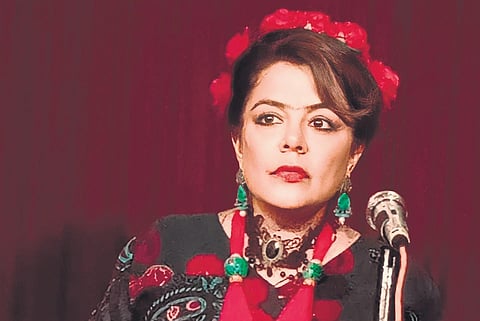

The colourful dress, a head full of flowers and the distinct unibrow, it is like looking at Frida Kahlo in flesh. As Kanika Aurora walks onto the stage dressed as the iconic Mexican painter, the rather compact space at Delhi’s Akshara Theatre transforms into an art gallery.
It is 1953 and Frida is speaking at the opening of her first and last solo exhibition at Galería Arte Contemporaneo in her home country. Her most famous paintings, Two Fridas, What the Water Gave Me and Self-Portrait with Thorn Necklace and Hummingbird, adorn the walls.
What follows is a moving 55-minute dramalogue, titled I am Frida, which encapsulates the painful yet rich life of the magnificent artist in the fictional speech. It touches upon her struggle as a child with polio; the near-fatal accident that rendered her immobile for almost three months and the pain that she carried till her last breath; her relationship with her parents and her artist-husband Diego Rivera, who she married not once, but twice. Her thoughts on motherhood, infidelity, sexuality, communism and being called a surrealist also find mention.
Speaking about the research that went behind the script, which she penned herself, Aurora says, “I read Hayden Herrera’s biography of the artist, and her journals to put the piece together. As I dug deeper, Frida engulfed me and she continued to stay with me even after the performance.” To replicate the voice of the artist and get the intonations on point, Aurora referred to the only voice recording that was available. “It is, however, disputed whether it is actually hers, but this is what I went by,” says the Delhi-based artiste.
The show was more than just a tribute. The ability of Frida’s emotions at different stages of her life to resonate with the audience is what made the performance crescendo. Everyone in the audience may not have been an artist trying to find an outlet to channel pain of such intensity, but it was not difficult to identify with the viva la vida principle she lived by. Frida soldiered on as vindicated by these lines, “What you didn’t know was that she wore a mask and the mask became the face. Get a colourful Tehuana dress to cover your crippled leg, get yourself some dazzling jewellery, and get a corset to support your shattered spine. You can do it!”
The connection with the audience forms the core of all of Aurora’s performances, whether it is acting in an ensemble play or one-person dramalogues. While she has been doing a lot of the latter lately, Sahir Ludhianvi, Sylvia Plath, Amrita Pritam, she started her theatrical career in plays by the late Aamir Raza Husain in the 90s, followed by brief stints with Barry John and the Company Theatre, after which she started working independently. In between, Aurora, who spent her growing up years in Hong Kong, also worked with British Airways in Delhi and Excel Institute in the US to earn enough to be able to pursue her true calling.
Aurora became Frida in more ways than one during her performance. When she says, “I have painted myself weeping, bleeding, cracked open transmuting my pain into art in all its truth—but have tempered it with some humour and some fantasy. Make life bearable, livable. My art, it is an autobiography in paint”, the peformer is not only speaking as Frida, but also herself. Aurora adds, “Like she depicts in her painting, Two Fridas, there are two versions of each of us—one with a bleeding heart and the other that nourishes it.”